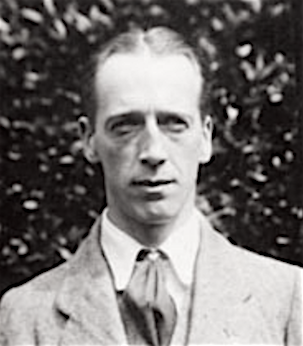Leslie MacDonald Gill [commonly known as MacDonald Gill] was born in Brighton, Sussex, England on 6 October 1884. His brother was the artist and designer Eric Gill (1882-1940). He was articled to the architect Leonard Pilkington from 1901 to 1903. He then worked as an assistant to Sir Charles Nicholson (1897-1949) and Hubert Christian Corlette (1869-1956) of Nicholson & Corlette, ecclesiastical architects in London from 1903 to 1908. During these years he took evening classes at Central School of Arts and Crafts in London. He commenced independent practice as an independent architect in London in 1908.
In addition to working as an architect, Gill was also a book illustrator, produced drawings and other decorations for Curwen Press; painted murals; and designed posters for the Empire Marketing Board, London Underground and the GPO. He sometimes collaborated with his brother Eric, notably in the design of the memorial for Dorothea Beale at Cheltenham Ladies College.
One of his earliest commissions came from the architect Edwin Lutyens who in 1909 requested him to paint a wind-dial for Nashdom, a house in Buckinghamshire. He subsequently painted seven more wind-dial maps for various properties including one at Lindisfarne Castle. By 1910 he had also begun designing stage sets, notably for the first production of John Galsworthy’s play Justice. He had also begun painting murals, including one of seven murals for the dining room of Borough Polytechnic in London in 1911.
In 1913 he was commissioned by Frank Pick, Publicity Manager for the Underground Electric Railways of London, to design The Wonderground Map of London Town, a poster map for the company. It was the first of several poster maps he produced for London Underground. He later also produced maps for Shell, the Empire Marketing Board, and for the ICI stand at the British Industries Fair in London in 1937.
From 1912 Gill shared a studio with the architect Arthur Grove (1869-1929) at 1 Hare Court in London.
During World War One Gill was employed as architect-in-residence on the Bladen Estate in Briantspuddle, Dorset. He also began illustrating books including 'Nursery Rhymes of London Town' by Eleanor Farjeon (London: Duckworth, 1916), and 'More Nursery Rhymes of London Town' by Eleanor Farjeon (London: Duckworth, 1917). Other projects from this period included a 17-foot tile map for an alleyway in Windsor, Berkshire and the covers for a number of journals.
In January 1918 Gill was engaged as a lettering adviser for the Imperial War Graves Commission Headstone Committee for whom he designed the alphabet and regimental badges for military headstones.
In 1926 he designed a house for himself and his family at West Wittering, Sussex.
In the early 1930s he began a relationship with Priscilla Johnston who had come to work for him as a research assistant on a map of Ceylon. She subsequently assisted him in the design of other maps including one for the RMS Queen Mary in 1935. Other commissions from this period included a new emblem for the General Post Office (GPO) in 1934; three posters for the GPO in 1935, 1937 and 1929; two circular glass maps for the Imperial Airways stand at the Exposition Internationale des Arts et Techniques dans la Vie Moderne in Paris in 1937; and a 200-foot-long mural for the UK Pavilion at the Glasgow Empire Exhibition in 1938.
During World War Two the Ministry of Information commissioned him to create graphics for several propaganda and military training films. He also designed propaganda posters for the Ministry. Following the war he painted a map for the Cunard liner Queen Elizabeth.
Gill was a member of the Art Workers Guild (AWG)in 1910 and a Fellow of the Royal Institute of British Architects (FRIBA) in 1931. He was also a member of the Society for the Protection of Ancient Buildings (SPAB) and the Architects Club. He died in Chelsea, London on 14 January 1947
An exhibition of his work was held at the Lettering Arts Centre, Snape Maltings in Suffolk in 2014.
Armstrong, Barrie and Armstrong, Wendy. The Arts and Crafts movement in the North West of England: a handbook. Wetherby, England: Oblong Creative Ltd., 2006
Armstrong, Barrie and Armstrong, Wendy. The Arts and Crafts movement in the North East of England: a handbook. Wetherby, England: Oblong Creative Ltd., 2013
Directory of British Architects 1834-1914. Compiled by Antonia Brodie, et al. Volume 1: A-K. London; New York: British Architectural Library, Royal Institute of British Architects/Continuum, 2001
‘Obituary’. Architects’ Journal 23 January 1947 p. 114
‘Obituary’. The Builder 17 January 1947 p. 93
‘Obituary’. RIBA Journal March 1947 p. 286
Stevens, Isabel. ‘Out of the Shadows: MacDonald Gill’. Icon no. 126, December 2013, pp. 124-125.
Walker, Caroline. ‘The map maker receives his due’. Country Life vol. 205, no. 29, 20 July 2011 pp. 96-97.
Wright, Herbert. ‘Maps to memorials: exploring the work of MacDonald Gill’. Blueprint no. 336, September/October 2014, pp. 232-233
